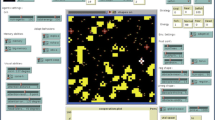Abstract
In this article, energy trophallaxis, i.e., distributed autonomous energy management methodology inspired by social insects and bat behavior, and its advantages, are shown by a series of computer simulations to address the survivability of organized groups of agents in a dynamic environment with uncertainty. The uncertainty of the agents’ organizational behavior is represented by two Lévy distributions. By carefully controlling energy donation behavior based on these distributions, we can examine the survivability of a larger group that traditional methods cannot analyze. As a result, even a small degree of friendship throughout the organization makes the group’s survivability improve dramatically.
Similar content being viewed by others
Explore related subjects
Discover the latest articles, news and stories from top researchers in related subjects.References
Holdobler B, Wilson ED (1990) The ants. Springer, Berlin
Wilkinson GS (1990) Food sharing in vampire bats. Sci Am (Feb):64–70
Melhuish C, Kubo M (2007) Collective energy distribution: maintaining the energy balance in distributed autonomous robtos. In: Distributed Autonomous Robotic System 6 (DARS 2004), Springer, Tokyo, pp 275–284
Kubo M, Melhuish C (2004) Robot trophallaxis: managing energy autonomy in multiple robots. Proceedings of Towards Autonomous Robotic Systems 2004, Department of Computer Science, University of Essex, Technical Report Series, CSM-415
Witkowski N (2007) Energy sharing for swarms modeled on the common vampire bat. Adapt Behav 15:307–328
Watts DJ (1999) Small worlds: the dynamics of networks between order and randomness. Princeton University Press, Princeton
Author information
Authors and Affiliations
Corresponding author
Additional information
This work was presented in part at the 14th International Symposium on Artificial Life and Robotics, Oita, Japan, February 5–7, 2009
About this article
Cite this article
Kubo, M., Sato, H., Matsubara, T. et al. High survivability of a large colony through a small-world relationship. Artif Life Robotics 14, 168–173 (2009). https://doi.org/10.1007/s10015-009-0646-5
Received:
Accepted:
Published:
Issue Date:
DOI: https://doi.org/10.1007/s10015-009-0646-5




